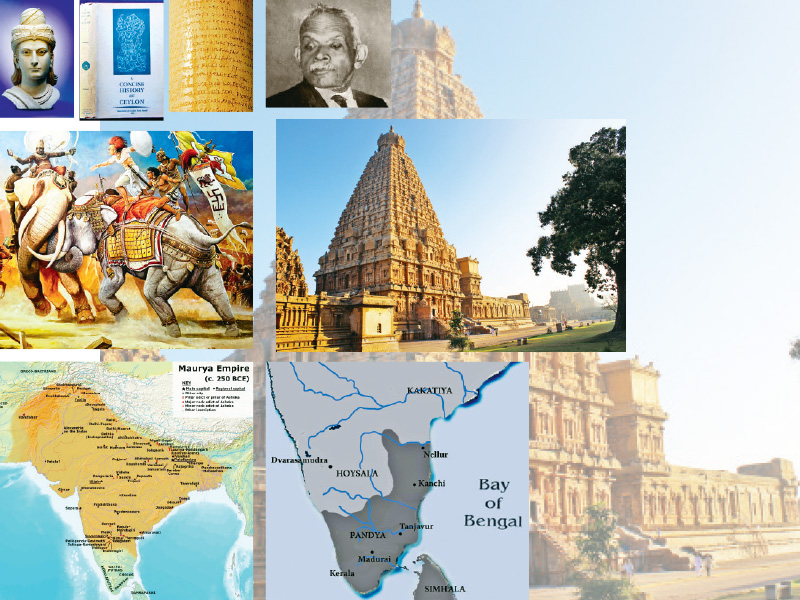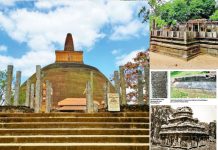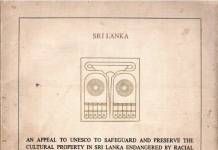In ancient Sri Lanka, according to inscriptions and chronicles, there had been an ancient ethnicity known as Dameda or Damela, who were merchants, sailors, monks, consorts, usurpers, and invaders. This does not necessarily say that they can be confidently identified as the modern Tamil ethnicity living in Sri Lanka today.
Asoka’s edicts and an ancient ‘Tamil country’
Asoka’s edicts are very important in constructing the history of the Tamils. According to his edicts, there were five kingdoms located south of the mighty Mauryan Empire. They are; Thambapanni, Chola, Chera, Pandya, and Sathiyaputhra. These edicts do not say anything about a country that is known as a Tamil land or a Tamil kingdom or a group of people named Dravida, Damila, or Thamil. In any of his inscriptions, these names do not appear which is surprising. It is clear that according to Asoka’s edicts, four kingdoms existed in South India which had different identities.
Four kingdoms mentioned in Asoka’s edicts
Five names of kingdoms are mentioned in Asoka’s edicts as kingdoms located beyond the Mauryan Empire and they are Thambapanni, Chola, Pandya, Sathiyaputhra, and Keralaputhra. Thambapanni can be identified as modern-day Sri Lanka.
Chola and Pandya countries are also identified as the Chola Kingdom and the Pandya Kingdom, both of which played an important role in Sri Lanka’s political history.
Identifying Sathiyaputhra has been controversial for decades. However, as mentioned in the book Demala Wansayata Purwikawak by Kolat Senanayaka and Narada Karunathilake, E. R. Subramaniyam has that Sathiyaputhra could be the area today known as Kondu. Kirshnaswami Ayyangar says it is the area known as Malabar. However, it is also said that Sathiyaputhra could be somewhere in ancient Amaravati which is modern-day Andra Pradesh.
Keralaputhra is identified as the modern-day Kerala area.
The question is that inscriptions found in Sri Lanka which belongs to approximately the same time as Asoka’s do mention Demala and Damida but why is that word absent in Asoka’s edicts?
Who are the ancient Dameda or Damila?
The word Damila, or Thamil or an indicator of a group or individual whose identity can be identified as Damila or Thamil cannot be seen in the southern part of India that can be dated to the pre-Christian era. Yet, interestingly, the oldest inscription bearing the name Damila or Dameda or Thamil that indicates Tamil is found in Sri Lanka. This is the inscription we have explained in our last two segments, which is known as the Tamil Householder’s Terrace Inscription read and interpreted by Prof. Senarath Paranavitana. There are a few more Brahmi inscriptions found in Sri Lanka that bear the word Dameda or Demala.
However, more interestingly, the Dameda or Demala individuals mentioned in these inscriptions do not bear personal names that have a Dravidian origin; but they bear names of an Aryan origin (Sanskrit – Sinhala). This is questioned and extensively explained by Senanayaka and Karunathilake in Demala Wansayata Purwikawak. What they attempt to say is that the individuals mentioned in these inscriptions whose ethnicity is mentioned as Dameda or Damela bear Sinhala names and almost all of these Brahmi inscriptions are about these Sinhala names bearing Damedas or Damelas doing donations or offerings to Buddhist temples.
This is something we need to take into consideration and examine further. Why would they have non-Dravidian or Sinhala names, when they are introduced as Damedas or Damelas? Who were these ancient groups of people known as Damedas that lived in ancient Lanka? Can they be identified as ancestors of the modern ethnicity known as Tamils? We need to study this further.
It is also interesting to learn that, according to Senanayaka and Karunathilake, the oldest notes (in historical texts) about a group of people called Tamil is from Sri Lanka which is about a group of invaders. These are recorded in our chronicles. Thus, to understand the history of the Tamil ethnicity, Sinhala and Pali chronicles, Sinhala inscriptions (including Brahmi script inscriptions) and coins discovered in Sri Lanka, and the ancient art and architecture of the Sinhalese are extremely important.
As we have explained in our previous segments, the word Dameda or Damila is found in Brahmi inscriptions in Sri Lanka. The history of Dameda or Damila in Sri Lanka dates back to the pre-Christian era, but does not predate the 3rd century BCE. We say this as we do not find any information in chronicles, nor archaeological evidence such as arts and architectural monuments that can be used to construct a continuous history of the Damedas or Damilas in Sri Lanka prior to the period of writing Brahmi inscriptions, which means prior to the 3rd century BCE.
However, some scholars attempt to construct a continuous history of a larger Tamil population or of a flourishing Tamil civilisation on the island dating back to the pre and proto-history of Sri Lanka. These arguments clearly collapse when they are being examined scientifically as no epigraphical, archaeological, literature, or numismatic evidence solidly supports these arguments. They are just fragmented data and weak arguments clearly analysing history from a racist perspective.
The biggest challenge in front of us now is to identify who are the group of people mentioned in inscriptions and ancient chronicles as Dameda or Damila. Are they ancestors of the modern Tamil ethnicity? This question should be answered scientifically.
Also, in the 5th century BCE, King Pandukabhaya settled various groups of people in the newly-built Anuradhapura city but the chronicles don’t mention or have any record of a group of people called Dameda or Damila being among the settled groups of people. This indicates that although many ethnicities and religious groups lived in ancient Sri Lanka during the 5th century BCE, Damedas or Damela were not among them. They are mentioned for the first time in the Brahmi inscriptions of Anuradhapura (The Tamil Householder’s Terrace Inscription). Prof. Paranavitana has dated this inscription to the 3rd to 1st century BCE based on the script of the inscription. Surprisingly, the names in this inscription are Sinhalese names such as Thissa, and Shaga.
Pandya, Chola, and Chera: Early Dravidians or Aryans?
In A Concise History of Ceylon by Prof. Paranavitana and C. W. Nicholas, the word Dameda is explained saying that the Brahmi inscriptions mentioning the ethnicity Dameda found in Sri Lanka could be the oldest inscriptions to mention them. In these inscriptions, Dameda or Damila individuals and groups are merchants, traders, or sailors.
The first Damilas to be mentioned in local chronicles are sailors who were engaged in horse trading. These traders were inhabitants of the areas of the Sindh River banks or in the vicinity and travelled further south by sailing. During these sails, they must have been engaged in horse trading.
The scholars Prof. Paranavitana and Nicholas further write that accounts of Tamil merchants and sailors are mentioned in the ancient Sinhala language and they had Aryan or Sanskrit names. Thus, explaining this, they say that prior to Dravidians migrating into South India these groups of people must have lived in the lower Indus Valley area and that is why they were highly influenced by the Aryan culture.
During historic times, areas where the Tamil language was in use were organised as Pandya, Chola, and Chera kingdoms, which are also mentioned in Asoka’s edicts. However, in A Concise History of Ceylon Prof. Paranavitana and Nicholas says that there is no sufficient evidence to say that the Pandya Kingdom was Dravidian during early times.
When the chronicles say that King Vijaya (of Sri Lanka) married a princess of the Pandya Kingdom, the Pandya princess or her group or the Pandya king is not mentioned as Tamils or Damilas.
According to Hindu epics (Sanskrit literature), the heroic Pandus (mentioned in The Mahabharata) are linked to the Pandyans of the South.
They further say that prior to the arrival of the Dravidians the Aryan culture was flourishing in South India. Before the arrival of the Dravidians in South India, the Pandya, Kerala, Chola, and Andra royal dynasties ruled various areas of South India. Once the Dravidians established their power and authority in the South, they continued to use the previous names and identities of the already existing kingdoms.
Considering all these arguments and facts, one thing is clear; constructing a continuous history of the Tamil people in Sri Lanka starting from the historic times is a bit of a task since almost all of the evidence we have is incomplete and/or fragmented. However, we know for sure the Damedas or Damilas lived in Sri Lanka since the early Anuradhapura time as merchants, sailors, consorts, monks, invaders, and usurpers.
Although some scholars attempt to draw a picture of the history of Tamils in Sri Lanka dating to the pre- and proto-history of Sri Lanka then we have a question; why this Dravidian influence or Dravidian culture did not rise to power in South India during the early pre-Christian era and why is there no evidence of a prominent Dravidian culture in Sri Lanka during the Historic times? A notable Dravidian culture was seen in Sri Lanka only during the medieval times and that too is due to the Chola invasions.
Although we had Dameda or Damila invasions during the Anuradhapura Period and they even ruled the country for decades, why we do not see a Dravidian influence until the Polonnaruwa Period? Is it because these early Damilas or Damedas were not exactly Dravidians? Is it due to the reason that invaders such as Sena Guttika and Elara were of an Aryan culture and travelled from the Sindh Valley?
Is it because prior to the rise of the Dravidian power in South India, an Aryan culture flourished in South India?
To be continued…
(Information courtesy; The Mahavamsa, The Arya Kingdom in North Ceylon by Prof. Senarath Paranavitana, A Concise History of Ceylon by Prof. Senarath Paranavitana and C.W. Nicholas, and Demala Wansayata Purwikawak by Kolat Senanayaka and Narada Karunathilake)
By Ama H. Vanniarachchy





